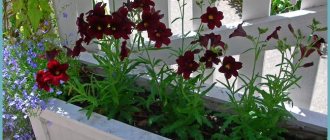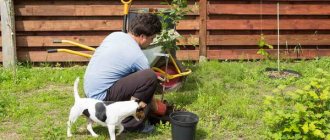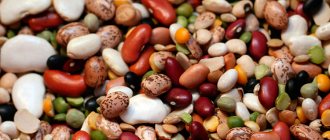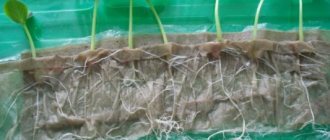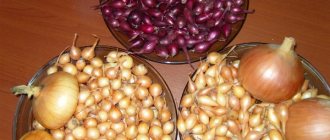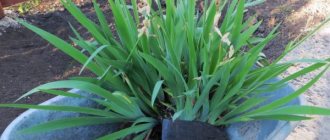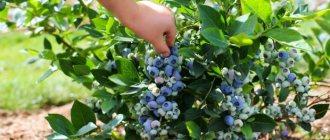Today I want to share my experience on how to plant peppers in open ground, sweet and bitter, which I grow mainly as seedlings, because this method has great advantages. But even in this simple matter there are pitfalls, and that is why I will share my experience. I’ll tell you how to prepare the seeds, plot, soil and seedlings. I’ll also tell you about my rules for caring for peppers after planting in open ground: watering, loosening, fertilizing. And if you follow these recommendations, you will grow peppers with a great harvest. But this is our goal, isn’t it?
Why do I plant peppers in open ground with seedlings?
Peppers are one of my favorite vegetables. Sweet is suitable for vitamin salads, delicious side dishes, stuffing, and preservation. Bitter - to add piquancy to your favorite dishes: soups, meat, stews, pies.
Gardeners are confused by the fact that pepper is a southern heat-loving crop. But I prove from my own experience that it is possible to grow it and reap an excellent harvest in Russian conditions. The main thing is to properly care for the plant from the very first days. There is nothing wrong with planting in open land. The main thing is to prepare the plant for harsh conditions and insulate the ridge.
In order to have time to harvest peppers at the end of summer, they are planted either in a greenhouse or as seedlings in open ground. This is a short-day crop: if the sun shines less than 12 hours a day, the pepper begins to bear fruit earlier and produces a better harvest.
Transplanting
Growing peppers in a summer cottage begins with the placement of young sprouts. The best time for landing is considered to be morning or evening. How to plant peppers correctly:
- carefully remove the sprout from the glass;
- place in the center of a pre-prepared hole, the depth of burial should not be higher than the root collar, otherwise the stem may rot;
- sprinkle with substrate and compact lightly;
- moisten the planting and mulch.
The best material for mulch is peat and old leaves.
Important! In the northern regions, summer residents use “warm beds”, when layers of rotted manure and straw chaff are laid at the bottom of the trenches. Afterwards, pour boiling water over the hole, sprinkle the soil and plant the seedlings.
In the first day after planting peppers in open beds, the seedlings may “sink” and the foliage may wither and even turn yellow. Don't worry about this, it's a natural process. The plant will soon recover and rise.
At what depth to plant pepper seeds depends on the planting pattern, but usually they are buried 2 cm, maintaining a distance of 3 cm
When to plant peppers in open ground
There are no clear planting dates for peppers in the agronomic literature:
- Sowing for seedlings: February 15 – March 15. For residents of the southern regions, the period shifts to early February - early March.
- Transplantation into an open bed: on the 60-90th day of seedling life.
Based on personal experience, many gardeners plant pepper seedlings at the end of March and transport them to the site by the end of June. I consider this method risky: the seeds often take a long time to germinate - they can “sit out” until the end of April. At this rate, by the end of May they are completely unprepared to move.
By region
I will give approximate dates for sowing peppers for seedlings in Russian regions:
- Southern. Beginning of February - beginning of March.
- Middle lane. Mid-second half of March.
- Northern. Second half of March - early April.
Planting seedlings in open ridges:
- Southern regions. End of April - mid-May.
- Middle lane. Second half of May - early June.
- Northern latitudes. First half of June.
These dates are approximate. Every year they shift depending on spring - early and late.
According to the lunar calendar
I will list the important dates of 2021 for gardeners who follow the lunar calendar:
- Planting pepper seedlings. February: 15-16, 28. March: 1, 8-9, 12.
- Transplantation into greenhouses. May: 8, 12-18.
- Planting in open ground. May: 12-18. June: 13.
I advise you to focus not only on lunar cycles, but also on the long-term forecast of weather forecasters.
Useful materials
Read other articles on the topic of pepper seedlings:
- Do I need to soak the seeds before planting?
- How to grow black peppercorns, chili, bitter or sweet at home?
- What are growth stimulants and how to use them?
- The main reasons why seedlings stretch, fall and die.
- Rules for additional lighting and feeding of young seedlings.
Seed selection
First of all, I recommend deciding for what purpose the peppers are needed:
- Use fresh. Large-fruited, thick-walled varieties: Gladiator, Gift of Moldova, Winnie the Pooh, California Miracle.
- Conservation. “Siberian”, small-fruited varieties: Ermak, Victoria, Kupets.
Here is a brief description of common varieties:
- Ermak. Early ripening variety: in warm regions, two harvests can be harvested per season from one bush. Characterized by relatively large fruits - up to 200-250 g
- Medal. Early ripening peppers with “extended” fruiting. Such plantings will bloom and bear fruit all summer. The fruits are bright red, with thick walls, weighing 150-200 g
- Gladiator. Mid-season variety bred by Dutch breeders. Peppers are rich yellow in color, with thick flesh. Fruit weight can reach up to 300-400 g
- Yova. Early ripening domestic variety: 90-100 days pass from the appearance of the first shoots to the ripening of the fruits. A productive crop that produces juicy fruits weighing up to 250 g. Yova is an unpretentious variety that grows well on a heavy substrate.
- California miracle. Early ripening peppers producing large, thick-walled fruits weighing up to 400 g
- Victoria. Medium-early small-fruited variety. Peppers are thin-walled, ribbed, weighing 100-130 g
- Black Cardinal. An Italian unique variety - the fruits are distinguished by their bright purple color.
I recommend planting 1-3 varieties at a time, and don’t forget to try new varieties.
Preparing seeds for sowing
Options for preparing seed material differ in terms of its shelf life:
- Up to 3-4 years. Seeds for seedlings can be sown dry. But to be safe, I soak them in warm water (about 50 C) for 24 hours.
- More than 4 years. Before planting, the seeds are soaked for a day in a solution of heteroauxin and a growth stimulant drug (Epina, Zircon, Ovary, Bud, Energen). With this preparation, germination rate increases from 60-70% to 90%.
soaking pepper in a growth stimulator
The next stage is germination:
- The seed material is wrapped in damp paper, cloth: napkin, toilet paper, rags.
- The resulting “envelope” with seeds is placed in a plastic bag, inflated with air, and tied tightly.
- The “parachute” is placed on a board or tray, which is taken to a warm place - to the kitchen stove, radiator.
Sprouts appear on the 2-3rd day. The hatched seeds are sown in 0.5 cm of moist soil. The most suitable substrate is peat. You can purchase soil for pepper seedlings at the garden center. It’s easy to “prepare” the soil composition yourself:
- 2 parts humus;
- 1 part garden soil;
- 1 part sand;
- 1 tbsp. spoon of ash per 1 kg of mixture.
Peppers are sensitive to transplanting and picking, so seedlings are grown in “permanent” cups until they are moved to the garden bed. The most successful are peat tablets. When transplanting, the seedling does not need to be removed from the bowl, injuring its roots. An alternative is plastic containers for sour cream, cottage cheese, yogurt with a diameter of at least 10 cm. It is not a pity to cut such a cup when replanting the plant.
containers for seedlings
With high-quality preparation, seedlings appear the very next day after sowing. Here are some recommendations for caring for seedlings:
- Optimal air temperature: 25-28 C. When it decreases, plant development slows down.
- Watering - as the soil dries out, only with warm water (about 30 C).
- The air in the room should not be dry - spray the plantings with a spray bottle.
- Protect fragile seedlings from temperature changes and drafts.
- The ideal location is the brightest window sill in the house.
If you sowed seedlings in February, they need additional lighting - artificial daylight from 7.00 to 21.00. 1-2 weeks before moving to a permanent place, young seedlings begin to harden - they are taken out to the balcony, gradually extending the time spent in the fresh air. But it is important to ensure that the temperature does not fall below 13 C.
pepper seedlings
Site selection and soil preparation
When planning plantings, leave the most illuminated, sun-exposed area of the garden for peppers. It is important that it is thoroughly protected from strong winds. I try to plant peppers along the south wall of my house. If there is no such protection, build it yourself: install a fence, plant strong “windproof” plants around the perimeter of the pepper bed.
Successful predecessors for this culture:
- all varieties of cabbage;
- pumpkin: zucchini, cucumbers;
- legumes;
- root vegetables: carrots, beets, turnips, radishes, daikon, radish.
Unsuccessful predecessors and neighbors are nightshades: tomatoes, potatoes, eggplants. It is not recommended to plan to plant a crop on the site of last year's pepper bed. The danger is that common diseases and pests of nightshade plants will be inherited by the seedlings.
growing bell peppers in open ground
The main requirements for the soil: breathability, high fertility, ability to retain moisture. I have been planning to prepare the site since the fall:
- I clear the ridge of previous “inhabitants”, weeds.
- I apply mineral fertilizers: 30-50 g of superphosphate per 1 m2 of plot.
- Scatter wood ash: 50-80 g per 1 m2.
- I add organic matter: 5-10 kg of humus per 1 m2 of land.
- I dig up the area using the bayonet of a shovel.
During the autumn preparation of the beds, I do not use fresh manure due to the threat of an excess of nitrogen. This is fraught with inhibition of the formation of ovaries and the ripening of peppers.
With such preparation in the spring, it is enough to thoroughly loosen the area and apply fertilizing (per 1 m2):
- Phosphate compounds: 30-40 g
- Nitrogen preparations: 20-30 g
- Potash fertilizers: 30-40 g
Additionally, you can disinfect the soil 5-7 days before planting seedlings: 1 tbsp. spoon of copper sulfate per 10 liters of water.
fertilizers for feeding peppers
Planting peppers: step-by-step instructions
Peppers are planted in greenhouses from mid-April. If the soil in the greenhouse is still frozen, turn on the heater and pour boiling water over the ridge. Black covering material helps to accumulate heat.
Depending on the region, heat-loving crops are planted in open ground from mid-May. Be sure to make sure there is no threat of frost. However, such early plantings should still be covered with “non-fabric” at night. If you do not have the opportunity to clean up and cover with covering material, I recommend planting the crop in the first ten days of June.
For peppers, I try to make “warm” high beds - using boards I raise them by 25-30 cm. This plant is subject to cross-pollination, so it is not advisable to place several varieties next to each other. Divide them with tall plantings - corn, tomatoes, sunflowers.
I will give a simple algorithm for transplanting young peppers, which I have been using for several years:
- Before planting, I water the seedlings generously.
- For transplanting, I choose a windless, warm, cloudy day - I carry out the work in the morning. If it is not possible to wait for the right weather, I plan the procedure for the second half of the day.
- I make holes according to the standard pattern of 70 x 30 cm. The hole should be slightly deeper than the height of the pot with seedlings.
- I water the dug holes generously with warmed water: 1-2 liters for each. I wait until the moisture is completely absorbed into the soil.
- I take a peat tablet with a plant and carefully move it into the hole. If the pepper grew in a cup, remember the walls of the container and gently tap the bottom. Carefully pull out the seedling by the base of the stem along with the earthen lump.
- Peppers are planted vertically, slightly deeper - this provides an incentive for the development of adventitious and lateral roots.
In conclusion, all that remains is to sprinkle the earthen ball with local soil and compact the substrate a little with your hands.
How to choose a place for pepper
If there is no space in the garden, then peppers can also be grown in bags filled with nutritious soil.
The pepper bed is placed in an area with moderately fertile light soil with a neutral or slightly acidic reaction. The crop does not grow well in places with close groundwater - then it is better to give it a high, warm bed.
Read about how to build such a bed in this article.
Pepper hates shadows . Therefore, plants must be exposed to the sun all day, otherwise their development will slow down and the harvest will be scanty.
And another important condition when choosing a vegetable plot is that it must be reliably protected from the wind.
To do this, at some distance from the garden bed, they make a partition or make a fence from any available materials. Alternatively, around the plantings, at a distance of 70-100 centimeters, you can place 1-2 rows of curtain plants - beans, corn, sunflowers, Jerusalem artichoke, chard. Plants must be sown or planted as seedlings in advance , 2-3 weeks before planting the pepper itself.
If you plan to keep the bed covered with film all season, there is no need to build additional protective barriers.
Legumes, onions, beans, pumpkin, squash, zucchini, root vegetables and cabbage are a list of successful predecessors for peppers. I do not recommend planting peppers after any nightshades, for example, potatoes, tomatoes, eggplants, or after any types of peppers. You need to wait at least 3-4 years before placing pepper in such a place.
Care after planting peppers
The optimal temperature for the development of transplanted peppers is 20-25 C. If it drops below, it inhibits the development of plants. Peppers take a long time to take root and get sick. When the temperature drops to 13-15 C, the plantings are covered with “non-fabric”. If purple inclusions appear on the leaves or stem, the plant is frozen.
To protect peppers from spring cold snaps, resourceful gardeners build “tents” from scrap materials: mesh, bars, cardboard, burlap. Heat-loving plantings require protection at night. In the morning the “tent” is dismantled.
Another option is a temporary greenhouse on arcs. The latter are driven into the ground, dense polyethylene and a special covering material are pulled over them. Two more folk methods are used to warm plants:
- Smoke. A fire pit is set up next to the plantings and materials are lit that provide thick smoke. This “smoking” helps the peppers survive the cold.
- Sprinkling. A special installation is used that systematically sprays warm water. Microscopic suspensions of liquid create a comfortable warm background around the peppers.
Peppers are very fragile when planted. Strong winds can cause them to bend or break. Therefore, seedlings are tied to pegs at the base, the thick part of the stem. I use linen, cotton scraps or old nylon tights. There is no need to tighten the shoots excessively so as not to disrupt the flow of cell juices.
Loosening
The root system of peppers needs a constant supply of air. Therefore, it is necessary to promptly break up the dense earth’s crust on the ridge after heavy rains and watering. I use a small hand hoe to loosen the soil to a depth of no more than 5 cm around the stem. Be careful: peppers tend to have shallow roots.
In addition to loosening, periodic weeding of the ridge is important. Hilling up of plantings is carried out as necessary - it is important to prevent exposure of the root mass.
Watering
To water the peppers, use only warm water: pour it into buckets in the morning and place them in a sunny place on a fine day. By evening, the liquid in the container will warm up evenly. If possible, replace the water from the pump or garden tank with rain water.
watering peppers in open ground
Watering is carried out taking into account simple recommendations:
- Before flowering begins. In cool weather - 1 watering per week, in hot weather - 2. For 1 m2 of ridge you need 12 liters of water.
- During flowering and fruit ripening. The frequency of watering increases to 2-3 per week. The consumption rate increases to 14 liters per 1 m2.
The optimal water temperature for peppers is 23-25 C.
Top dressing
This crop does not have enough nutrition added to the soil when preparing the bed. The first feeding after transplantation is with the appearance of new leaves. For 1 liter of water: 1 g of potassium compound, 3 g of superphosphate, 0.5 g of ammonium nitrate. A second fertilizer with the same dosage 2 weeks later. If the plant develops slowly, it is allowed to exceed the fertilizing norm.
Pepper care
The main care of pepper bushes after planting consists of timely weeding, loosening the soil, regular watering and fertilizing at certain periods of the plant’s life. It is also important to form the bush and, if necessary, prepare supports, since tall varieties need staking. All this will have a beneficial effect on increasing fruiting.
Watering and fertilizing
The plant loves regular watering; you can do this once every 5 days in the morning. The volume of liquid for an adult bush is 2 liters, and one is enough for a young plant. The best water is rain or warm; tap water is also suitable, which must be left to stand for 24 hours. It is better to water closer to the root system, avoiding moisture getting on the leaf plates.
When growing in greenhouses, after moistening the substrate, it is necessary to carry out daily ventilation, however, avoid drafts. In hot weather, part of the film cover can be removed.
Plants planted in the ground are fertilized 3 times:
- 2 weeks after transplantation, it is better to add diluted chicken manure at a rate of 1:20. Each bush will require 1-2 liters.
- During the period of ovary appearance: mullein, diluted with water 1:10. You can also fertilize with ash or add 6 g of superphosphate, 2 g of potassium and 1 g of ammonium nitrate to 1 liter.
- At the beginning of the harvest, the recipe is the same as for the first point.
You need to approach the application of fertilizing carefully; a lack or excess of certain substances is reflected in the appearance of the bush:
| Lack of element | External signs |
| Potassium | Dryness and curling of leaves. |
| Phosphorus | The lower part of the leaf blade is purple. |
| Nitrogen | Changing the color of greenery towards a gray shade. |
| Magnesium | Marble coloring of the crown. |
Loosening
Every other day, loosening the soil and weeding is recommended. For better drainage, soil looseness and moisture retention, mulch made from sawdust, compost or humus is used. Weeding and removing weeds will help protect plants from pests and prevent infection with dangerous diseases.
Bush formation
During the growing season it is necessary to prune the bushes several times. This is done in order to get rid of dense and shaded areas, as well as too long growing shoots. For many varieties, pinching is necessary: shoots and leaves below the main fork are removed. If not 2, but 3 stems come out of it, then the third should also be removed. Typically, the formation of a bush is carried out after harvesting the fruits or once every 10 days. Low-growing and hybrid varieties usually do not require pruning.
Towards the end of July, you need to stop the growth of the bushes by pinching the tops, and leave only the ovaries, and all the buds must be cut off. This will allow you to get large peppers that will have time to ripen by September.
The number and size of fruits can be controlled by leaving a lot on strong bushes and reducing the number by removing excess flowers on weaker ones. Also, on each plant in the fork a fruit is formed that produces a substance - an inhibitor. If you need large peppers or your own seeds for sowing, leave it and remove it at the level of the ovary to obtain small ones.
What difficulties may arise when growing peppers?
The main difficulty that you may encounter when growing is diseases and pests that are characteristic of all nightshades:
- "Blackleg". The disease affects seedlings and leads to the death of the young plant. To prevent it, seeds must be disinfected before sowing. During pepper growth, it is important to avoid waterlogging and monitor the optimal temperature conditions.
- Withering. The development of the disease is indicated by the shedding of leaves, a brown tint of the tops, the main stem, and individual vessels. The disease affects already mature plantings.
Pathogens are bacteria, fungi and viruses that live in the soil, inherited from their predecessors, and introduced into the substrate with organic fertilizer. Methods of counteraction and prevention are simple:
- Purchasing quality seeds, disinfection before sowing.
- Following the rules of crop rotation.
- Timely control of pests and weeds.
- Destruction of the diseased plant.
Effective treatment is the use of fungicides. Be sure to follow the instructions for the drug so as not to harm the seedlings and to protect yourself.
Peppers suffer from “traditional” garden pests - aphids, slugs, and mites. Chemicals are used last. Pests can be easily controlled using traditional methods:
- Aphid. For a bucket (10 l) of warm water - 200-250 g of wood ash. The liquid is mixed until smooth. Damaged leaves are irrigated with the composition using a sprayer or broom.
- Spider mites. For a bucket (10 l) of water: finely chopped garlic or onion - 200 g, chopped dandelion tops - 200 g. To increase the effectiveness of the solution, add 30-40 g of laundry soap shavings (or the same amount of liquid). The components are mixed until homogeneous. The mixture is infused for at least 24 hours, after which the affected plantings are sprayed with it.
- Slugs. You can resist the pest by regular loosening and using straw mulch. If slugs have already “attacked” the peppers, they are collected by hand, and the surface of the soil around the plant is dusted with red pepper or dry mustard (1 teaspoon per 1 m2 of area).
slugs in the garden
aphids in the garden
Following these simple tips is enough to get a tasty, rich harvest. I would like to note that all procedures, from sowing seeds for seedlings to treating pests, must be carried out in a timely manner and with high quality. Only in this case will the plants thank you with delicious peppers.
Pests and diseases
Readers often ask questions about what ails peppers. Most often, sweet peppers are affected by diseases such as verticillium (wilt), bronzing (spotted wilt), phytoplasmosis, fusarium, late blight, apical and gray rot, and blackleg.
- Plantain: cultivation, properties, application
Verticillium is a fungal disease that exists in three forms: brown, green and dwarf, each of which manifests itself in its own way. Since the destruction of pathogens by pesticides on vegetable plants is undesirable, only preventive measures remain: the destruction of all plant residues in the fall and the cultivation of varieties resistant to verticillium.
Phytoplasmosis, or stolbur, is manifested by the fact that the roots of the plant begin to rot, dwarfism develops, the fruits grow small, thin-walled and tasteless, the leaves curl, harden and turn yellow, and as a result the pepper dries out. They carry the disease of leafhoppers. The fight against phytoplasmosis is carried out by treating peppers with Acara at the time of planting and three weeks after it - spraying the vegetable at this stage of development will not cause harm. In addition, it is necessary to regularly loosen the soil on the site and remove weeds.
Fusarium is a fungal disease that causes peppers to turn yellow: the leaves acquire a poisonous yellow color. Diseased specimens are destroyed, and the remaining plants are carefully looked after: watered moderately in the morning, and weeds are not allowed to appear on the site. Keep in mind that next year it is better not to grow pepper in a site infected with fusarium.
Late blight is a common fungal disease that affects peppers and tomatoes. Symptoms of phytosporosis are the formation of hard spots on the fruits that trap the pulp. They destroy pathogens with the drugs Oksikhom, Zaslon, Barrier, but only before the pepper begins to bloom. By the way: hybrid varieties are much less susceptible to disease.
Blackleg affects the root part of the stem of pepper seedlings as a result of too dense sowing and keeping the soil and air at high humidity. Over time, the stem softens and the seedling dies. To avoid the disease of seedlings with blackleg, you should sow the seeds spaciously, pick the seedlings in time and monitor the humidity level in the greenhouse. If you find diseased seedlings, immediately remove them, dry and loosen the soil in which the seedlings grow, and sprinkle it with wood ash. At this stage of plant development, it is permissible to spray seedlings with Zaslona solution in the ratio: 3 caps of the drug per 1 liter of water.
Blossom rot occurs on the plant, oddly enough, in case of lack of moisture and appears as shiny or black deep spots on the fruit. Sometimes the cause of the disease can be excess nitrogen and calcium in the soil. Infected plants are burned, and the rest are sprayed with calcium nitrate.
Gray rot can affect every plant at any stage of development with putrefactive spots and a gray coating of mold. Its appearance is usually provoked by rainy weather. Affected fruits and parts of the plant must be removed, and the bushes in the area must be sprayed with fungicides, if it is not too late.
Signs of bronze wilt, or spotted wilt, appear as brown spots on leaves that take on a bronze or purple hue. These necrotic spots are located mainly along the main vein of the leaves. As a result of the development of the disease, the top of the plant dies, the fruits in the stalk area become covered with green, brown or pale yellow ring spots. To save the harvest, ripe fruits are picked off and the soil is no longer watered. The fungus is destroyed by Fundazol, however, before treating the pepper with a fungicide, weigh again all the pros and cons of such spraying.
Pests that plague peppers include aphids, spider mites, wireworms and slugs. You can help protect the plant from slugs by scattering nut shells, ground hot pepper or mustard powder over the area. You can also place bowls of dark beer here and there, to which shellfish will crawl from all over the area. And do not forget to loosen the soil between rows to a depth of 4-5 cm in the heat.
The larvae of the click beetle, or wireworms, remain in the soil for five years and gnaw on plant roots. To get rid of wireworms, in the fall the soil on the site is dug up, and in the spring, before planting peppers, several baits are placed on the site by burying pieces of sweet root vegetables in the ground and marking these places for yourself. Click beetle larvae will definitely crawl towards these baits. Every two to three days the baits are dug up, the larvae are collected and destroyed.
Spider mites infest plants in dry conditions; they settle on the underside of leaves and suck out the cell sap from them. If you don’t know how to treat peppers against ticks without resorting to insecticides, we offer you a recipe for a solution that is non-toxic to the human body: mix a tablespoon of liquid soap or dishwashing detergent with a glass of finely chopped onion or garlic, as well as chopped dandelion leaves in 10 liters of water, let it brew and spray the pepper with this mixture at any stage of its development.
Get rid of aphids with wood ash or tobacco dust infused in 10 liters of hot water in the amount of one glass. You can also, if necessary, use a treatment of pepper with a solution of quickly decomposing insecticides such as Karbofos or Keltan at the rate of one tablespoon of the drug per 10 liters of water.


